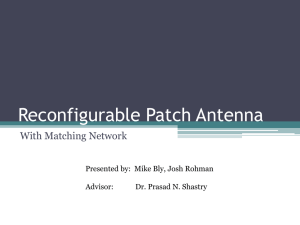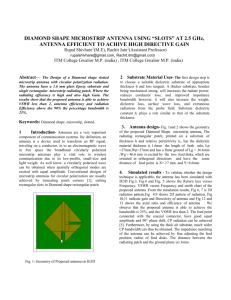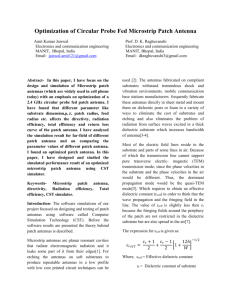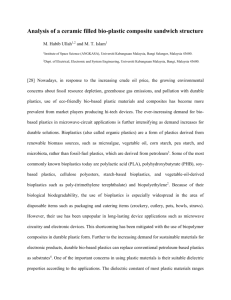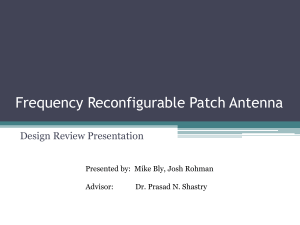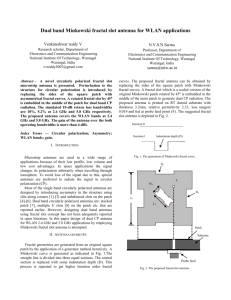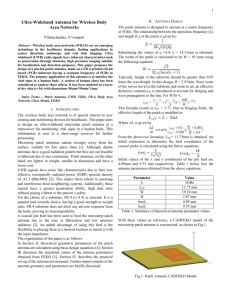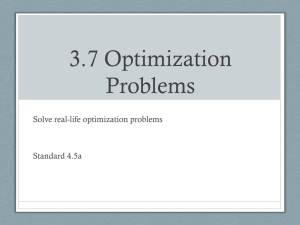Abstract- - ER Publications
advertisement
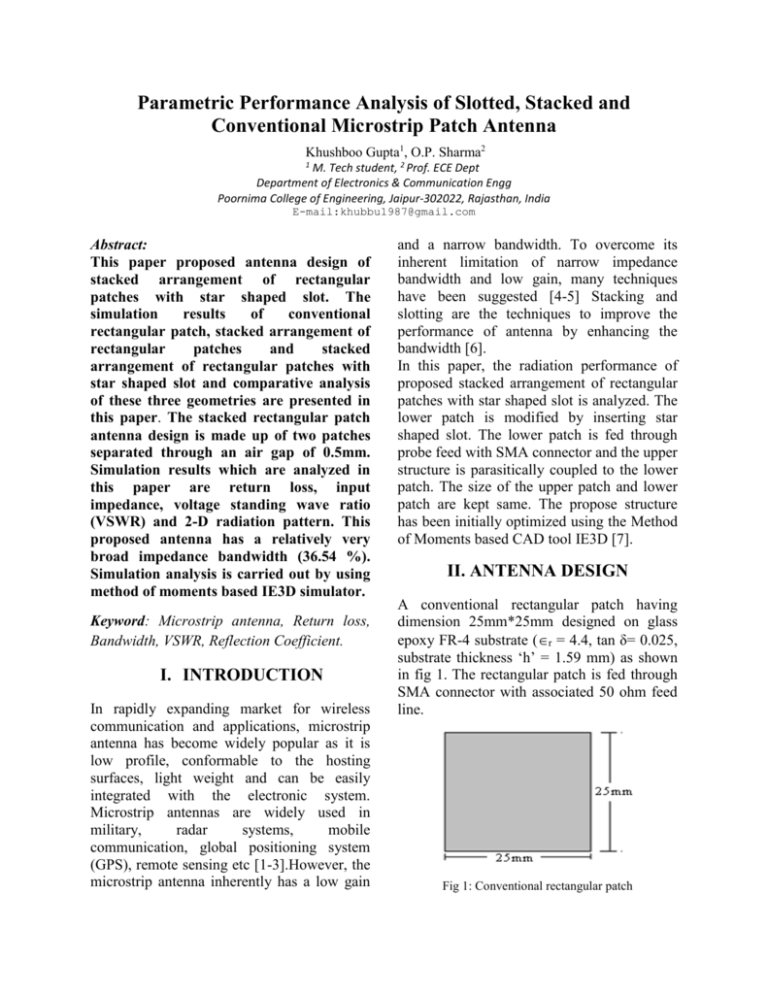
Parametric Performance Analysis of Slotted, Stacked and Conventional Microstrip Patch Antenna Khushboo Gupta1, O.P. Sharma2 1 M. Tech student, 2 Prof. ECE Dept Department of Electronics & Communication Engg Poornima College of Engineering, Jaipur-302022, Rajasthan, India E-mail:khubbu1987@gmail.com Abstract: This paper proposed antenna design of stacked arrangement of rectangular patches with star shaped slot. The simulation results of conventional rectangular patch, stacked arrangement of rectangular patches and stacked arrangement of rectangular patches with star shaped slot and comparative analysis of these three geometries are presented in this paper. The stacked rectangular patch antenna design is made up of two patches separated through an air gap of 0.5mm. Simulation results which are analyzed in this paper are return loss, input impedance, voltage standing wave ratio (VSWR) and 2-D radiation pattern. This proposed antenna has a relatively very broad impedance bandwidth (36.54 %). Simulation analysis is carried out by using method of moments based IE3D simulator. Keyword: Microstrip antenna, Return loss, Bandwidth, VSWR, Reflection Coefficient. I. INTRODUCTION In rapidly expanding market for wireless communication and applications, microstrip antenna has become widely popular as it is low profile, conformable to the hosting surfaces, light weight and can be easily integrated with the electronic system. Microstrip antennas are widely used in military, radar systems, mobile communication, global positioning system (GPS), remote sensing etc [1-3].However, the microstrip antenna inherently has a low gain and a narrow bandwidth. To overcome its inherent limitation of narrow impedance bandwidth and low gain, many techniques have been suggested [4-5] Stacking and slotting are the techniques to improve the performance of antenna by enhancing the bandwidth [6]. In this paper, the radiation performance of proposed stacked arrangement of rectangular patches with star shaped slot is analyzed. The lower patch is modified by inserting star shaped slot. The lower patch is fed through probe feed with SMA connector and the upper structure is parasitically coupled to the lower patch. The size of the upper patch and lower patch are kept same. The propose structure has been initially optimized using the Method of Moments based CAD tool IE3D [7]. II. ANTENNA DESIGN A conventional rectangular patch having dimension 25mm*25mm designed on glass epoxy FR-4 substrate (r = 4.4, tan δ= 0.025, substrate thickness ‘h’ = 1.59 mm) as shown in fig 1. The rectangular patch is fed through SMA connector with associated 50 ohm feed line. Fig 1: Conventional rectangular patch The stacked rectangular patch antenna design is made up of two patches separated through an air gap by using Teflon screws as shown in fig 2.The lower patch having dimension 25mm*25mm, an air-gap layer with dielectric permittivity 1 and thickness ‘d’ = 0.5 mm is between the lower and upper patches. The upper patch has same dimension as the lower patch. The lower patch named as driven element is feed through SMA connector and the upper patch is parasitically coupled to lower patch. Fig 3: Modified rectangular patch III.SIMULATION RESULTS AND ANALYSIS In this section simulation results for single rectangular patch, stacked arrangement and proposed stacked arrangement with star shaped slot are presented. Fig 2: Side view of stacked arrangement The proposed stacked arrangement of rectangular patches with star shaped slot design is made up by modification in above stacked rectangular antenna design to achieve better performance. The modification applied only on the driven patch and the stacked patch is kept same as shown in fig 2. The modified rectangular patch has star shaped slot as shown in fig 3 and is considered as driven element. Both these patches are designed on glass epoxy FR-4 substrate and separated through an air gap of thickness 0.5 mm. The dimensions of both patches are kept same as in stacked arrangement. This arrangement of patches is simulated with method of moment based IE3D simulation software. 1. Reflection Coefficient v/s Frequency Reflection coefficient plot determines the return loss of antenna. Return loss is a logarithmic ratio measured in dB that compares the power reflected by the antenna to the power that is fed into the antenna from the transmission line. Fig 4: Reflection coefficient v/s frequency plot of single patch Reflection coefficient v/s frequency plot for single rectangular patch is shown in fig 4. Return loss is -33.26 dB at resonant frequency 2.76 GHz. In fig 5 the stacked rectangular patch antenna has dual operating frequencies, one is 5.23 GHz and other one is 6.01 GHz. The return loss at 5.23 GHz is -45.13 dB and return loss at 6.01 GHz is -28.80 dB. The bandwidth of the stacked rectangular patch antenna system is 31.87%. 2. Input Impedance v/s Frequency The variation of input impedance of antenna as a function of frequency is shown by smith chart projected in fig 7, 8, 9 for three different geometries. Fig 7: Input impedance v/s frequency plot of single Fig 5: Reflection coefficient v/s frequency plot of stacked arrangement patch The simulated input impedance of single rectangular patch as shown in fig 7 at resonance frequency is (50.05–j0.01) ohm which suggests excellent matching between antenna and feed arrangement. Fig 6: Reflection coefficient v/s frequency plot of stacked with star slot arrangement In fig 6 the stacked with star slot patch antenna has triple operating frequencies, first is 5.30 GHz, second is 2.57 GHz and third is 6.79 GHz. The return loss at 5.30 GHz is 41.26 dB, return loss at 2.57 GHz is -27.43 dB and the return loss at 6.79 GHz is -22.92 dB. The bandwidth of stacked with star slot rectangular patch antenna system is 36.54%. Fig 8: Input impedance v/s frequency plot of stacked arrangement In fig 8 stacked rectangular patch antenna has impedance (50.41+j0.40) ohm at 5.23 GHz frequency and (50.45-j2.96) ohm at 6.01 GHz frequency. For single rectangular patch the value of VSWR at resonant frequency is 1.08, which is near about the ideal value of VSWR (unity). Fig 11: VSWR v/s frequency plot of stacked Fig 9: Input impedance v/s frequency plot of stacked with star slot arrangement In fig 9 stacked with star slot rectangular patch antenna has impedance (49.31+j0.20) ohm at 5.30 GHz frequency. 3. VSWR v/s Frequency: The parameter VSWR is numerically describes how well the impedance of antenna is matched to the transmission line. Fig 10: VSWR v/s frequency plot of single patch arrangement In stacked rectangular patch antenna at frequency 5.23 GHz, the VSWR is 1.02 and at 6.01 GHz frequency the VSWR is 1.07 as shown in fig 11. In stacked with star slot rectangular patch antenna the VSWR is 1.09, 1.02 and 1.15 at frequency 2.57 GHz, 5.30 GHz and 6.79 GHz respectively as shown in fig 12. Fig 12: VSWR v/s frequency plot of stacked with star slot arrangement 4. Radiation pattern The elevation radiation pattern shows E-plane and H-plane radiation pattern at resonant frequencies. Fig 15: Elevation pattern gain display of stacked with star slot arrangement Fig 13: Elevation pattern gain display of single patch The simulated elevation pattern plot for single patch, stacked arrangement and stacked with star slot arrangement is shown in Fig 13, 14 and 15 respectively. The radiation patterns in entire bandwidth are almost identical in shape and uniformly radiate in all directions. IV. DISCUSSIONS AND CONCLUSION Fig 14: Elevation pattern gain display of stacked arrangement The radiation performance of stacked with star slot rectangular patch is simulated by using IE3D simulation software. Simulation results and comparative analysis are presented for all three geometries. It is realized that the proposed stacked with star slot rectangular patch design is dual band, triple frequency operative antenna compared with stacked rectangular patch that is single band, double frequency operative antenna. It is realized that proposed antenna has 36.54% bandwidth which is around 10 times larger as compared to conventional microstrip patch antenna. Parametric comparison results among these three geometries are presented by chart in fig 16. Fig 16: Parametric comparison among different geometries REFERENCES 1. R. Garg, P. Bhartia, I. Bahl, and A. Ittipiboon, Microstrip Antenna Design Handbook, Artech House, Norwood, Mass, USA, 2001. 2. D. Sanchez-Hernandez and I.D. Robertson, “A survey of broadband microstrip patch antenna,” Microwave journal, pp.60-84, September 1996. 3. A. Rani and R.K. Dawre. “Design and Analysis of Rectangular and U Slotted Microstrip Patch for Satellite Communication”,International Journal of Computer Applications, Vol-12, No.7, June 2010. 4. S. Shekhawat, P. Sekra, D. Bhatnagar, V.K. Saxena and J.S. Saini"Stacked Arrangement of Rectangular Microstrip Patches for Circularly Polarized Broadband Performance." IEEE Antennas and Wireless Propagation Letters, Vol. 9, pp 910-913, 2010. 5. Mohammad Tariqul Islam and Mohammed Nazmus Shakib, “High Gain Microstrip Patch Antenna”, European Journal of Scientific Research, Vol.32 No. 2(2009), pp.187-193. 6. Khushboo Gupta and Pankaj Garg, “Stacked Arrangement of Microstrip Patches with Hexagonal Slot for Broadband Application”, International Conference on Electronics, Electrical and Computer Engineering, ISBN: 978-93-82208-09-9, pp 83-86, August 2012. 7. IE3D User’s Manual, ZelandSoftware, Inc., Fremont, USA.
